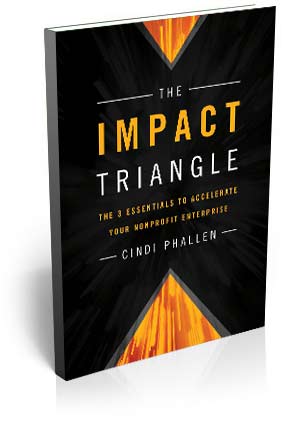The 3 Essentials to Accelerate Your Nonprofit Enterprise
Leading a nonprofit business can seem like an overwhelming struggle, surrounded by competing priorities. But it doesn’t have to be that way. The Impact Triangle, by Cindi Phallen, outlines a proprietary formula for success in social impact organizations. It provides answers to the most common challenges facing nonprofit leaders: planning, building stronger boards, fundraising, and staff management. This solution-oriented book walks you through how to focus on the right things:
- Mindset
- Relationships
- Winning practices
With this solid foundation, you will win back the joy of doing what it takes to transform lives and change the community without the chaos!
Audio Interview
In the Measurement Resources Webcast Audio Interview with Sheri Chaney Jones, Cindi discusses why she wrote this book and outlines the three things nonprofit leaders must do to break the cycle of chaos to start achieving extraordinary results.
From Chapter 24: “Five Steps to Board Success in Fundraising”
As with the other projects and initiatives you face, board fundraising can be highly successful when you apply the Impact Triangle principles. Ask yourself these questions: What is your mindset when you consider board fundraising? If you are an executive director, are you creating barriers that keep board members at arm’s length? If you are a board member, are you hesitant to jump into uncharted waters?
Here are the steps to take to develop successful fundraising board members:
- Tell them you expect them to fundraise right at the start. The first time you interview them about their board candidacy, tell them they are expected to personally invest, as well as to invite others to donate. If they are fighting the urge to go screaming into the hills, assure them that staff will provide them with all the tools they need to be successful, and create an individual strategy for them. If they do eventually join the board, review expectations in the board orientation. Ask for questions. Reassure them, have an experienced board member show how it has worked in the past, and start talking about the importance of identification and cultivation. Right here I just listed four ways to outline and support fundraising expectations—when you do this, there will be no surprises.
- Deal with the scary stuff early. Remember the scary F word? This is all so normal! So talk about it and help volunteers understand that fundraising isn’t about chasing down rich people. It’s about having a strong mission and leveraging relationships in a way that matches the donor’s interests with community needs. When done well, potential donors…


